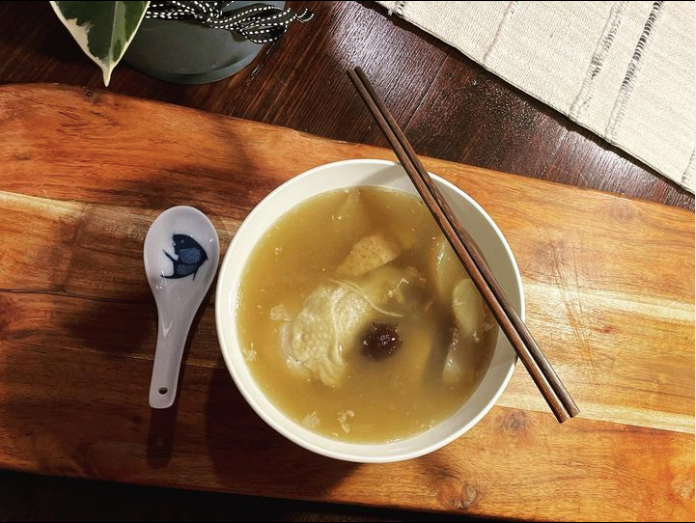Bone broths have really entered the social consciousness in the past few years and with good reason. They are nutritious, nourishing and delicious and have many health benefits from both the western and Chinese medicine perspective.
What is a Bone Broth?
A bone broth is a protein filled liquid made from the long and slow cooking of meaty joints or bones in water. A bone broth is similar to a stock however the bones used and the long cooking time are what sets it apart. A really good bone broth will have a gelatinous jelly like texture when cold.
Why are Bone Broths so Good?
Bone broths are full of nutrients, vitamins and minerals. Due to their high gelatine content, bone broths assist in the production of collagen.
A number of studies such as this one, show that the consumption of gelatin results in increased collagen synthesis. Collagen is a protein that is naturally produced in the body and assists in joint health and maintaining the health, hydration and elasticity of the skin. Due to the high gelatin content of bone broths. Regularly drinking bone broth may help in the prevention of joint issues such as osteoarthritis as well as reducing the signs of ageing.
Bone broths are also high in amino acids, such as glutamine. Some studies have shown that glutamine can improve the intestinal barrier and may improve conditions such as leaky gut syndrome. Some of the amino acids found in bone broths can also be anti-inflammatory and help to promote the proper functioning of the digestive system.
In Chinese medicine bone broths are seen as warming and nourishing, aiding in digestive health and replenishing the bodies natural energy or qi. One of our practitioners Steve Clavey uses a great analogy to explain why warming foods, like bone broths, are easy on the digestion.
"Chinese medicine imagines that the stomach is a furnace and food is digested through maintaining heat and warmth in this furnace. Warm foods such as broths, stews, porridge, soups, help to maintain and stoke this digestive fire, while cold foods require the body to produce the heat to enable digestion. Warm foods therefore require less energy to digest and allow the body to use this energy to instead maintain balance and support the healthy functioning of the rest of the body."
How do I make a bone broth?
Bone broths are cheap and easy to make (aside from the long boiling time). You can use any meaty bones, though the best bone broths will be made with bones that contain lots of cartilage, marrow or both, to ensure a wonderful gelatin content.
Ingredients
- 1.5kg of Bones (pork, beef, chicken)
- 1 tbs Olive oil
- 12 cups of water
- 1 tablespoon of vinegar
- Optional Vegetables (Carrot, Celery, Onion)
- Optional Spices (Garlic, Star Anise, Cinnamon)
- Optional Chinese Herbal Soup Packs (See shop)
- Optional Step: Blanching is an optional addition which enables you to remove the impurities from the bones and make a clearer and more clean tasting bone broth. It is not completely necessary but recommended to do if you have the time. To blanch the bones put the bones in your large pot, cover with water, bring to the boil and simmer strongly for 20 minutes. Once simmered, drain the water and impurities and rinse bones.
- Brown the Bones: Pre-heat your oven to 220 degrees. Place the bones on baking tray and drizzle with olive oil. Place in the oven for 45 minutes, turning half way. Browning the bones is a great way to add flavour to your bone broth.
- Put the Bones in your Stock Pot: Once browned put bones in a clean stock pot scraping up any bits from the bottom of the baking tray. Cover the bones with water (approximately 12 cups or enough to completely cover), add the vinegar and place on the stove, bringing the liquid to a low boil with the lid on.
- Simmer the Broth: for 8-12 hours with the lid slightly ajar. Add water to the broth if necessary to keep the contents covered. If you need to cook overnight, you can cool the broth, put it in the fridge and resume cooking the following day. If using spices or vegetables they can be added at this point. Add herbal soup packs in the last hour of cooking.
- Strain: Once the bones have simmered for at least 8 hours (the longer the better) it is time to strain. You can use either a wire mesh or a cheesecloth to strain the bones and any additions out, with a cheesecloth providing the cleaner result.
- Let the broth cool: Divide the broth into serving containers once cooled and freeze any broth you won't be consuming at the time. Bone broths are great in the freezer and this is the best way to retain nutritional value and freshness.
- Enjoy! Bone broths can be consumed as a stand alone option, made into a soup with vegetables or Chinese herbs, used for soup noodles or for replacing stock in a recipe.
Check out our Chicken Soup Recipe for Post Pregnancy or our other food related blogs on seafood or Hayfever, Asthma & Eczema.
Need something stronger? Book an appointment with one of our expert practitioners and or get in touch to start the journey to better health!
Don't live in Melbourne? Did you know we are available for phone and online consultations Australia wide. Check out our services page or get in touch to discuss how we can help you!

